Suru Valley is one of those places that would never be on the standard traveler’s list. For, there is no fanfare, no flashiness, no pomp & show, Suru Valley doesn’t receive the traveler-love it deserves. Situated in the Kargil District, Suru is an integral part of Ladakh.
While most people choose to zip through the valley to reach the more acclaimed brother – Zanskar Valley, I am here to tell you why you MUST spend time in this tiny piece of heaven. This valley is the last of the unexplored valleys of God’s Creation. While, yes, Ladakh, in general, can be considered off-beat, Suru Valley takes it up a notch or two.
Suru is extremely popular in the mountain climbers’ circuits, thanks to the massifs of Nun and Kun. With so much to offer, it is necessary to speak about the beauty of this valley.
Let's quickly dive into the details:
About Suru Valley
Suru Valley is formed by around the catchment area of the Suru River – a tributary of Indus River, fed by the Panzella glacier. The confluence of the Suru River with the Indus river at Nurla is a sight to behold as multiple other tributaries also converge here, including the Dras river.
People of this beautiful perfection are primarily descendants of Dard and Tibetans. Geographically, The Suru Valley separates Kargil from the Zanskar Valley. The strict-looking red harsh mountains and the pleasantness of the lush green valleys are both peaceful and intimidating in the best ways!
It is the greenest valley of the Greater Himalayas, which is such a shock to the system at over 3000-meters altitude. Especially, if you’re on your way to Zanskar – remember to relish in every bit of the greenery – it will be essential – you won’t see any for long stints of your travels!
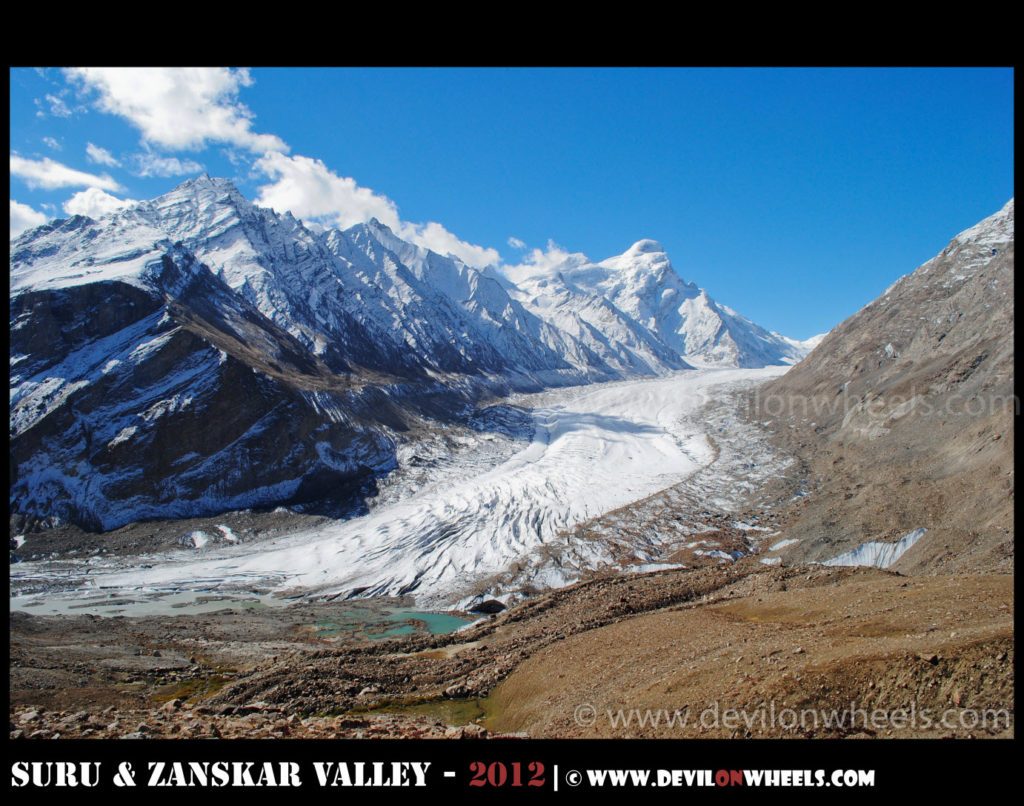
Geography
Suru valley comprises the far west of Ladakh and is situated at an average elevation of 3000 meters. Starting from the major town of Kargil, Suru Valley extends it’s up to the Penzi-la glacier, where the Suru river originates.
The lower Suru Valley is one of the most agriculturally fertile regions of Ladakh wither two crops being harvested annually. All this is thanks to the presence of the Suru river and nearby melting glaciers.
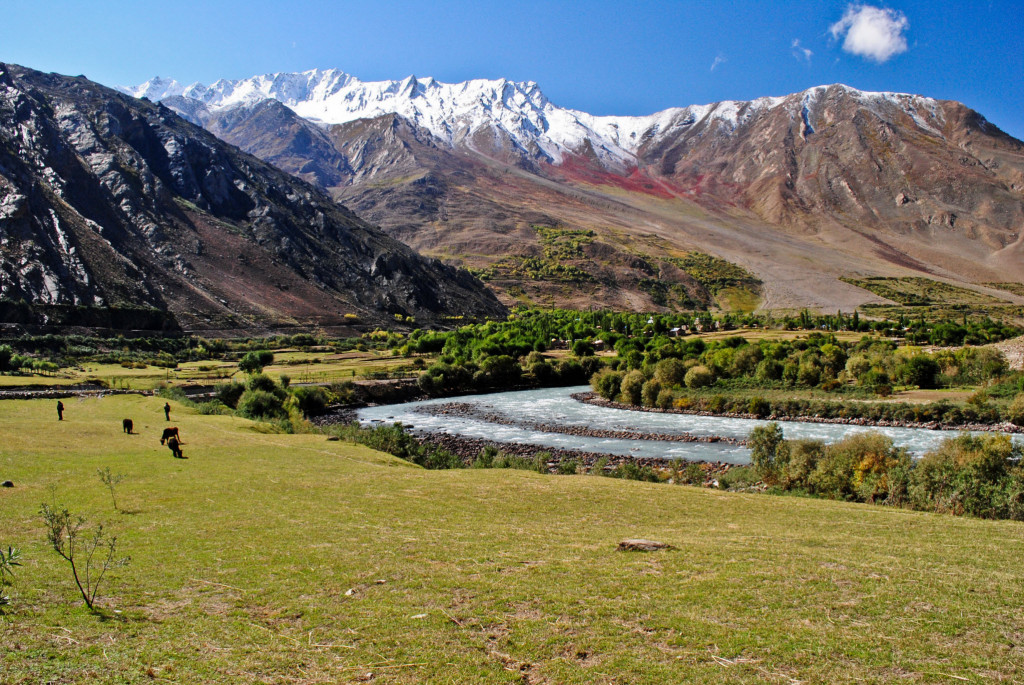
Best time to visit Suru Valley
While theoretically the road to Suru is connected mostly throughout the year, the winter period in the valley is unabashedly harsh, it is wise to avoid visiting the place during that time unless you’re an extreme adventure traveler. It is not for the faint-hearted with the entire place covered completely in layers of snow.
You will also encounter road blockages then! You should ideally pack in a few days into your Ladakh trip and reserve them for the gorgeous Suru Valley. The valley is at its most bountiful and provides giving everything it has to offer – gorgeous sunsets and sunrises, beauty as far as the eye can see, and pleasant weather to go out and explore.
The presence of farmland in the valley is what gives it its unique charm – and you can experience that to the fullest during May – September.
You should our article on the best time to visit Ladakh and Zanskar Valley for a more detailed description.
How to reach Suru Valley
Suru has situated 308 km from Leh and 292 km from Srinagar. Both routes will take you to Kargil, which is approximately 100 km from the gorgeous valley. Reaching Ladakh that has multiple options. You may choose any of the below options.
By Air
There are direct connecting flights from Delhi to Leh, Ladakh. Major airlines such as Air India, Go Air, Vistara all fly to this beautiful airport, cradled by the mountains. It is advisable to ask a medical practitioner on the suitability of AMS medicine, for traveling to high altitudes.
Alternatively, Srinagar airport is also well connected with the Capital. From both these airports, you can hail cabs for reaching Suru. However, I would highly suggest including Suru in your overall plans of the region and explore Srinagar/Leh at your leisure before heading out.

By Train
The nearest railway station is Srinagar and from there you can take cabs/ hail buses for your way to Kargil.
By Road
This is the best and arguably the most enriching way to get to Ladakh. You may choose to use your vehicle or take a cab or even hail a bus. All options are available.
Reaching Kargil
To get to Suru Valley, one must be in Kargil and take the well-paved road towards Suru Valley. There are two major routes – you may choose the Srinagar – Kargil – Suru route, or you may choose the Manali – Leh – Kargil – Suru Route.
Buses are available; however, for visiting certain villages of the valley, such as Rangdum, Padum, you can hire a cab as a daily bus service might not be available.

From Kargil
I would highly recommend having a meal at Kargil before commencing your journey towards Suru Valley. You should also prepare yourself with all the supplies that might be needed here.
There is a “teacher’s bus,” which leaves at around 7 AM. This time makes it perfect for the teachers who live in Kargil, to reach the schools in the Suru valley on time. Hence the name! This bus goes to Sankoo village.
There are regular bus services that connect Sankoo, Parachik, and Panikhar to Kargil. A bus ride from Kargil to Sankoo, Parachik, and Panikhar takes 2, 3, and 4 hours respectively. Padum and Rangdum are connected with a bi-weekly bus service.
Distance Map of Suru Valley
- Kargil to Sankoo 42 km
- Sankoo to Karpokhar 5.3 km
- Karpokhar to Damsna 31 km
- Damsna to Panikhar 5 km
- Panikhar to Tangol 10 km
- Tangol to Parkachik 6 km
- Parkachik to Rangfum 46 km
Exploring Suru Valley
Ranging from the Buddhist village of Kartse Khar to the heavenly plateau of Rangdum, every corner of Suru Valley is worth visiting. The pristine, untouched landscape that you’ll experience in this region will be unmatched to any other place you’ll visit.
The most dramatic sights of the region are thanks to the Nun and Kun massifs at an elevation of 7035 and 7035 meters, respectively. The massif has some outrageously spiky peaks.
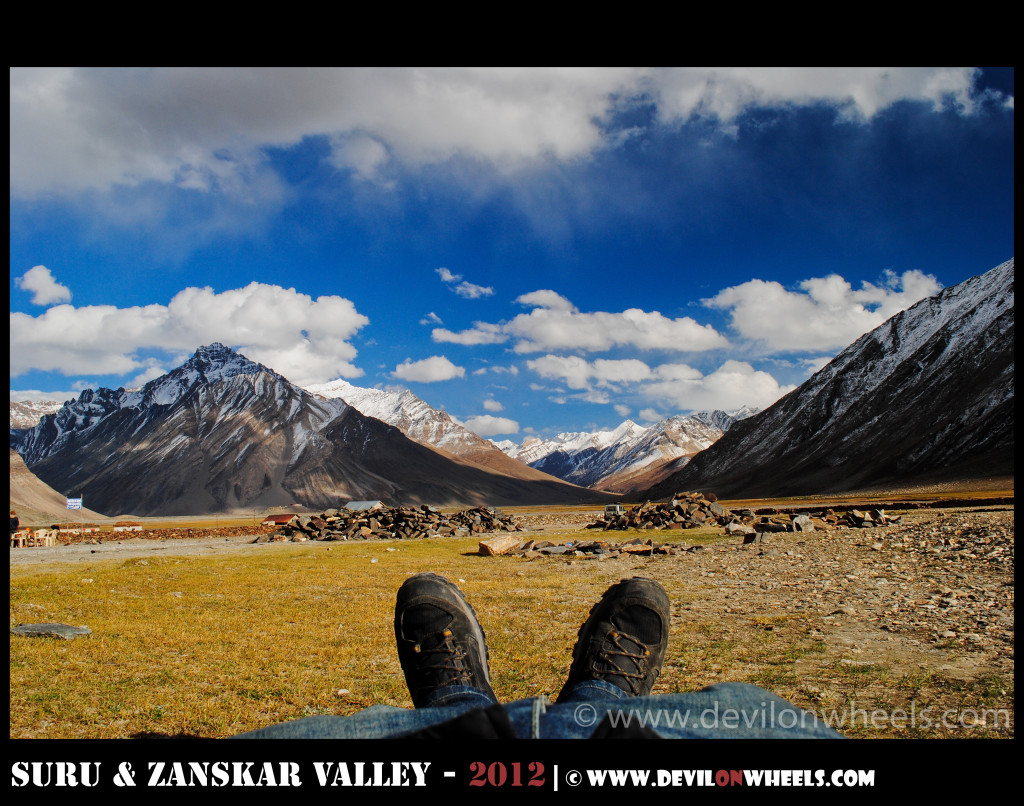
Trekking in Suru Valley
Adventure enthusiast knows of the region thanks to the peaks of Nun and Kun. Unlike Stok Kangri – this trek require weeks of pre-planning and attaining permits and waiting for the right weather conditions.
Nun peak can be approached from Tangol or farther off from Parkachik, whereas for Kun, you’ll start by trekking from Gelmatonguz, 10 km of Parkachik. This valley holds a lot of respect in the mountaineering circuit – so much so, that the annual fest – Suru Boulder Fest – is a much loved international event near the Gontabsa village.
Unfortunately, Kashmiri treks such as the Panikhar and Pahalgam or even up to Baltal are not recommended due to strong army movement. Still, you can take the Sapil lake or even the Rushi La trek from Sergole to Sanku.
Other options include the Warwan Valley loop from Panikhar, which will take you up to two high passes and a whole lot of adventure. You can arrange such tours in Kargil itself. You can even head on to the Nun base camp in the region, which is the home to the 7135 meters high mountain
Places to visit in Suru Valley
The entire valley is home to some of the most stunning views. Some of the must-experience places include –
Sankoo
With lush plantations, Sankoo is shaped like a bowl and is a somewhat popular spot for a break. With wild roses and plantations – you have an ideal place to relax and take in the views. One of the greenest pastures in all of Ladakh, Sankoo is often known as “Ladakh’s Gulmarg”.
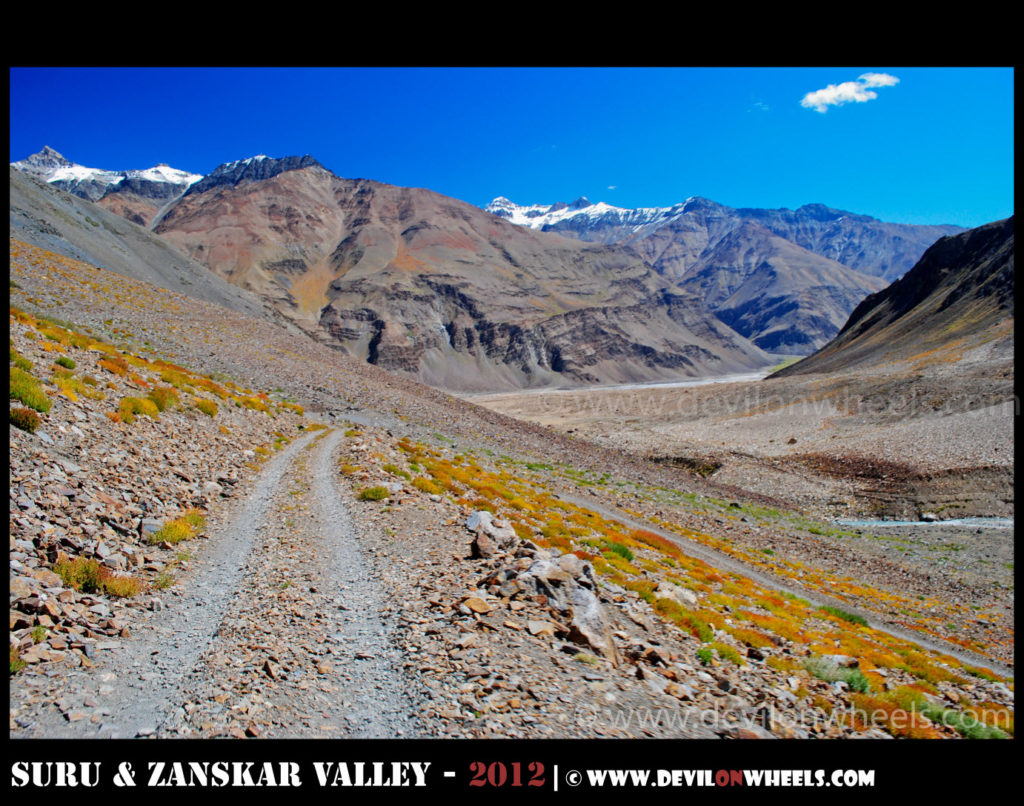
Kartse Khar
An ancient Buddhist village, Kartse Khar has its roots back in the 7th century and houses a 7 ft tall Buddha statue.
Panikhar
A beautiful ruined fort is situated in Panikhar, which was constructed by Zorawar Singh. Panikhar is also the prime spot for clear views of Nun-Kun mountain massifs will are at an elevation of 7035 and 7135 m, respectively. You can choose to partake the day-long trek from Pursa on the bypass road for some spectacular views.
Rangdum
The plateau of Rangdum forms the farthest, and hence the most unexplored regions in the valley. An extended oblique plateau, Rangdum offers a unique view. With hills on one side and rocky mountains and glaciers on the other – the views are gorgeous.
Situated at an elevation of 3657 meters, Rangdum is cold, windy yet strikingly beautiful. There is an 18th-century monastery that is home to 40 monks. This place is the last inhabited region of the valley, and post this, the valley climbs to the heights of 4400 meters, leading up to Pensi-la glacier with twin lakes.
Where to stay
When you’re visiting Suru Valley, you’ll be in extreme isolation, even more, intense that some other valleys of the region. Thus, majorly, good guest houses are available in Kargil.
However, there are Jammu and Kashmir Tourism Bungalows at many locations in the valley including, Rangdu, Tangol, and Purtikchay, as well as many summer camps with bedded tents across the valley in various little settlements. Homestays are also welcome here, and you will be able to experience the true culture of the region.
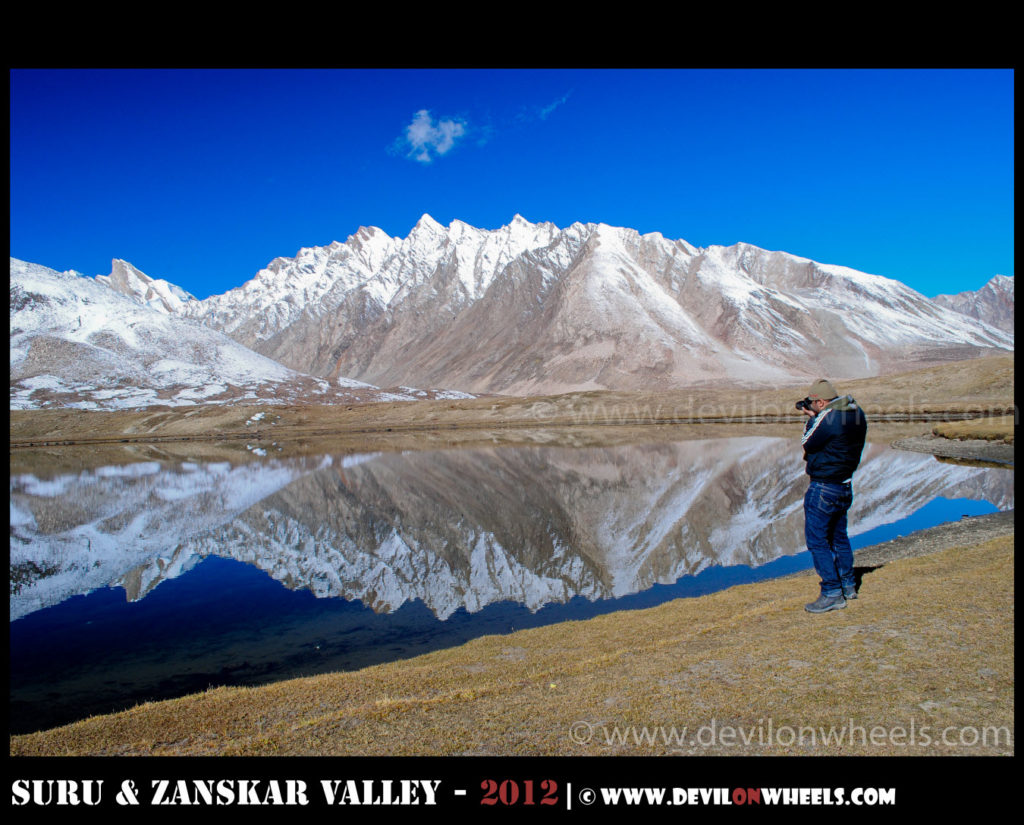
What to eat
As with the rest of Ladakh, limited options for food are available. Though what is available is usually lip-smacking. There are a few tea-shops along the way as well as near the monastery in Rangdum.
Three are snack stalls at Sankoo, which is a popular picnic spot along with two below a bridge in Parkachik with stunning glacier views. It is advisable to carry your own snacks/food items for the way. Also, you must carry your water bottles and fill them up where possible.
FAQ
Are there any petrol pumps in Suru Valley?
Get Petrol at Kargil. No petrol pumps are present in Suru Valley.
Is there phone connectivity in the Valley?
You will not be connected to the outside world after Kargil. In theory, some places get extremely limited signals on the postpaid BSNL/ MTNL connects, but, don’t count on it. Also, there are satellite phones available in a couple of places in the valley – but those should be used only for emergency situations.
Do check out the detailed article on mobile connectivity in Suru and Zanskar Valley.
Is there electricity connectivity in Suru Valley?
The Rangdum monastery recently got electrified with solar power. The guesthouses will have some electricity intermittently. However, mostly, electricity is also like connectivity – erratic and undependable. Carry charged power banks to charge your phones/cameras etc.
Can a person experience AMS Here?
Absolutely, you are at exceptional heights and chances of AMS are very real. It is always wise to take full precaution for any sickness when at such heights. It is also necessary to be hydrated and listen to what your body is telling you.
Is an inner line permit required for Suru Valley?
No, inner line permits are not required to visit the Suru and Zanskar Valleys.
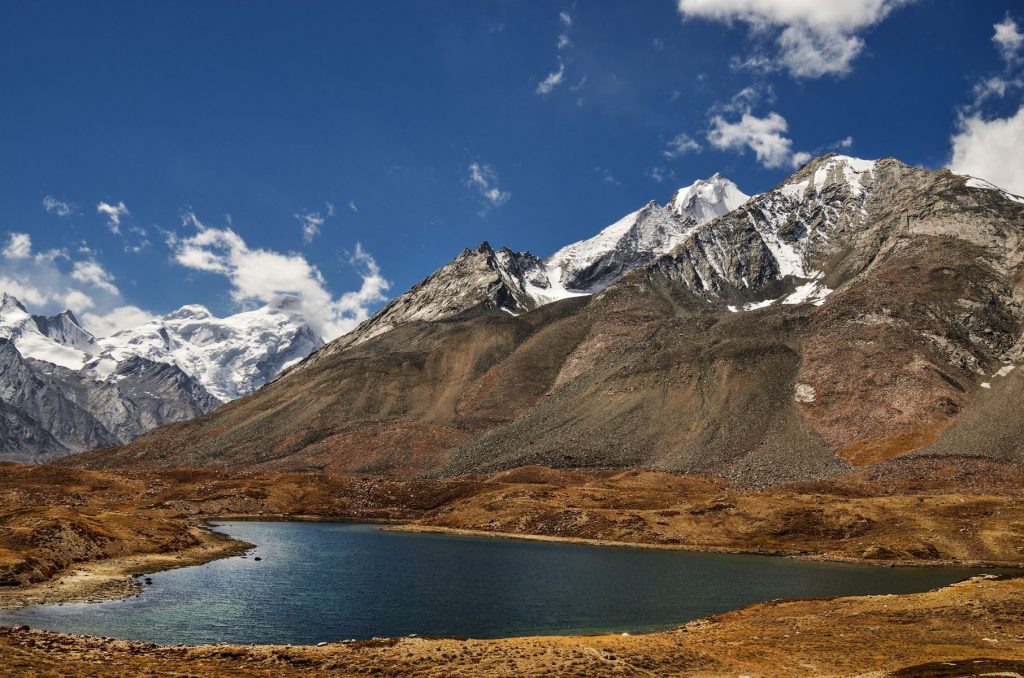
Conclusion
There is a reason that most adventure-loving people love this place – the beauty that lies here is unmatched by most places in the world. The extreme calm, the challenging yet beautiful environment all add up for an unforgettable experience.
Have a travel question?? You can subscribe to my YouTube channel and leave a comment to ask your travel questions about traveling to the Himalayas.
Suru Valley is home to the most welcoming of lands, especially in the lower tranches of the valley. When you visit Ladakh, one MUST detour into the Suru Valley to truly understand the beauty of the place.





